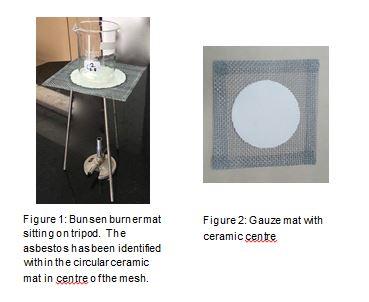Contact WorkSafe
Tel: 1300 307 877
Email us
24 hour serious incident and fatality reporting line
Freecall: 1800 678 198
Mason Bird Building
303 Sevenoaks St
Cannington WA 6107
View on Google Maps
Tremolite asbestos has been identified in the ceramic centre of some Bunsen burner gauze mats in New Zealand and the UK, and preliminary testing has indicated that this may be an issue in gauze mats in Australia. Further testing is underway to confirm this in relation to Australian gauze mats.
The circular ceramic material in the centre of the gauzes is used for its heat-resistant properties. The gauzes with ceramic centre are used with tripods and Bunsen burners as shown in Figures 1 and 2.

Gauze mats which do not have a ceramic centre (ie they are all wire) are outside the scope of this alert because they are not likely to contain asbestos.
All types of asbestos were prohibited in Australian workplaces from 31 December 2003, unless in situ prior to this date.
Preliminary analysis of the ceramic material has identified that it contains fibres, some of which are potentially tremolite asbestos. The fibres are bonded to the ceramic material. Any risk from asbestos depends on the extent of asbestos fibre release and inhalation of these fibres.
The risk from asbestos in the ceramic material from normal gauze mat use will generally be extremely low for several reasons including the following:
As a result, any free fibre release into the air will be minimal for normal use. However, if the material becomes soft and crumbly, some small particles or fragments may detach on occasions including during use. Particles and debris may also break off over time through abrasion or impact in storage.
Although steps have been taken by work health and safety regulators to prevent further supply, it is recommended that workplaces adopt a precautionary approach.
People should not handle, use or move their current stock of Bunsen burner gauze mats until they have checked with their supplier to find out whether they are likely to contain asbestos.
If the supplier cannot provide analysis information in relation to tremolite asbestos, assume the gauze mats contain asbestos and dispose of them as outlined below.The relatively low cost of replacing the gauze mats will far outweigh the cost of having the gauze mats tested.
The work to dispose of asbestos-containing gauzes and waste items is a low-risk activity, but it still needs controls in line with legal requirements. The work should only be done by people who are confident they can follow the guidance below and have access to the right equipment. Alternatively, employers may choose to engage a licensed asbestos removalist.
As the asbestos fibres are bonded to the ceramic material, personal protective equipment is not required when handling the gauze mats. However, duty holders may wish to adopt a precautionary approach regarding the use of disposable respirators and personal protective clothing.
Where non-asbestos containing gauze mats are stored directly alongside asbestos-containing gauzes, these should be treated as contaminated waste. Other equipment which has been stored with asbestos-containing gauze mats, and the storage area, should be wiped clean with a wet wipe if there is any visible dust present. The cloth should be disposed of as contaminated waste.
The gauze mats should be wetted using a hand-held spray bottle containing water with a small quantity of detergent (eg washing-up liquid) and handled carefully to prevent any further damage. The gauze mats should be contained for disposal by placing them in either:
Any excess water and dust/debris from the gauze mats should be wiped up using a wet wipe, damp rag or paper towel and the wet wipe, rag or paper towel should be disposed of in the same manner as the gauze mats.
Once the immediate clean-up and containment has been completed, the waste must be taken to a landfill site licenced to accept asbestos waste.
Obtain analytical data in relation to the batch of gauze mats you are purchasing, or choose all-wire gauze mats. Ensure the analytical methods used are scoped to include detection of tremolite asbestos.
Last modified: